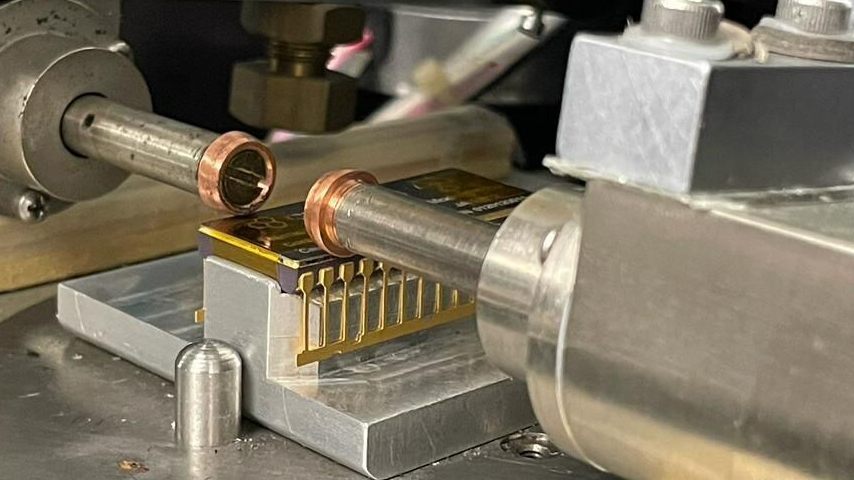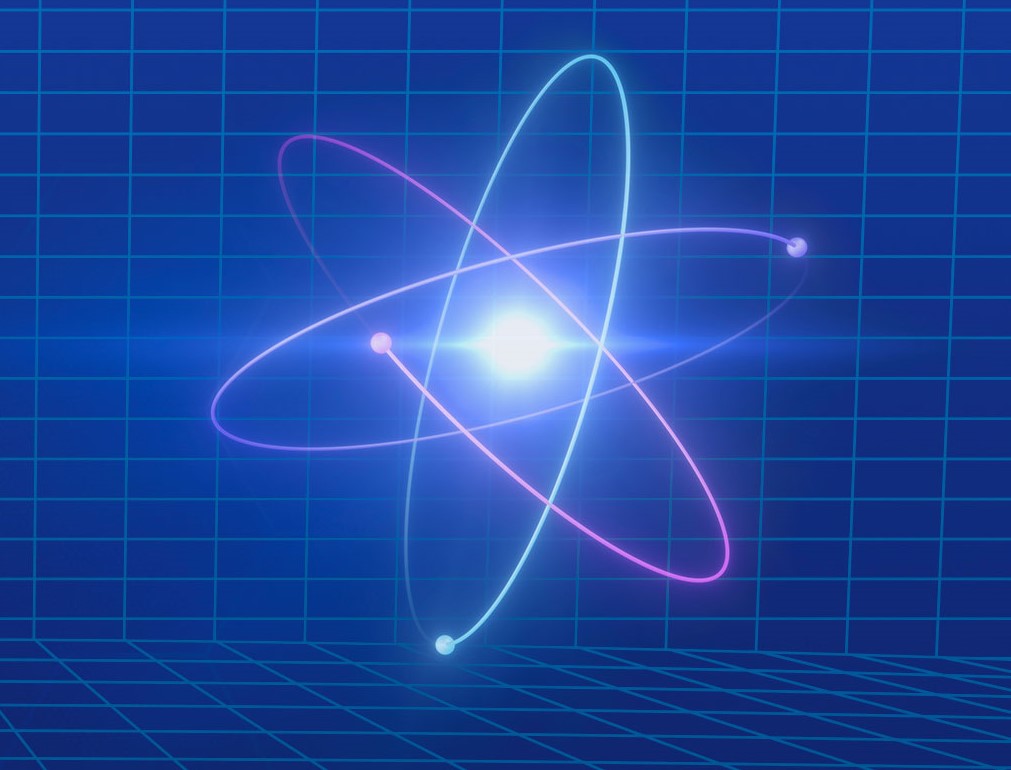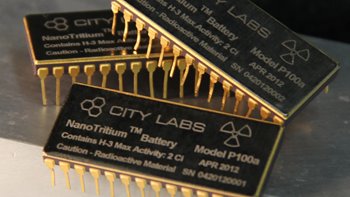Tritium Battery Gets NASA’s Attention
Tritium Battery Gets NASA’s Attention


These 20-year batteries convert the energy of decaying atoms particles into electricity to power microelectronic devices such as low-power sensors, microelectronics, and microcontrollers.
The power of nuclear reactions help propel U.S. Navy aircraft carriers. Now NASA is looking to develop a prototype battery based on the decay of tritium atoms for use in future space missions.
The batteries are the outgrowth of a two-year research project recently completed by City Labs, a company in Miami, Fla. Peter Cabauy co-founded the company in 2005 in hopes of finding an entrepreneurial application for his doctorate in applied physics. He quickly focused on processes related to radioactive decay of tritium, a form of hydrogen with one proton and two neutrons with a half-life of 12.32 years.
“The decay process is immune to changes in temperature or environmental decay, making it a very reliable timer and an interesting way to power devices,” Cabauy said.
During its radioactive decay, one of the tritium atom’s neutrons changes into a proton—turning it from a hydrogen isotope to a helium isotope—and emits an electron (also called a beta particle) in the process.
City Labs taps this steady electron production to make electricity. The company has designed, developed, and manufactured ultra-low power (nanowatt-to-microwatt) tritium-powered nuclear batteries that can last more than 20 years. Unlike conventional, chemical-reaction-based batteries, a tritium battery will continue emitting low-powered electrons independently of temperature or any environmental conditions. That makes them attractive to use in such applications as microelectronics, sensors, and other devices employed in the aerospace, defense, medical, and industrial sectors.
NASA uses radioactive decay to power some of its far-ranging probes. Those radioisotope thermoelectric generators capture the heat from the decay to run a small thermoelectric cell. Most of these generators use plutonium as the radioisotope source, making them potentially hazardous in case of an accident.
More on batteries: Sodium-Ion Batteries Are Powering Up
By contrast, while tritium is not found in nature, it is produced in certain types of nuclear reactors and benign enough to use as an illumination source for exit signs in schools, theaters, commercial buildings, and commercial aircraft. Instead of relying on the small amount of heat produced by the decay of tritium, the City Labs battery embeds the tritium into a semiconductor. Just as the incident light on a photovoltaic cell produces a voltage that drives electric current, the emission of a beta particle by the decaying tritium atom produces a voltage.
This type of energy harvesting is called betavoltaics. Betavoltaic batteries have three main components: the battery housing, semiconductor junction, and the tritium metal hydride.
Selected for you: Bolstering Batteries with Zinc
“Although tritium is the most benign of radioisotopes—for example, beta radiation can be stopped by something as thin as a sheet of paper—it is extremely important to make a robust housing package,” Cabauy said. “Along with the housing, the semiconductor junction and the tritium metal hydride source, there are other areas we continue to research and push toward making smaller and more powerful devices.”
Betavoltaics can operate in environments between -55 ºC and 150 ºC with little to no loss in efficiency in the most common operating range of 40 ºC to 0 ºC. These batteries can also be customized according to dimensions, power requirements, and semiconductor features required for such devices as low-power sensors, microelectronics, and microcontrollers.
After developing the battery, Cabauy never realized how challenging it would be to gain regulatory approval. “It was a huge hurdle to overcome,” he said. “It took us several years to receive our Sealed Source Device Registration, which allows us to ship these devices to anyone.”
 Cabauy also did not anticipate how much his company would depend on mechanical engineers to design and build these batteries. “Nearly all areas of R&D and manufacturing need and require the mechanical engineer’s capability and mindset, from the basic components of the tritium betavoltaic battery to the regulatory process,” he said. “Everything we do requires CAD modeling, simulations, and environmental/longevity testing and our mechanical engineers best equipped to handle these challenges.”
Cabauy also did not anticipate how much his company would depend on mechanical engineers to design and build these batteries. “Nearly all areas of R&D and manufacturing need and require the mechanical engineer’s capability and mindset, from the basic components of the tritium betavoltaic battery to the regulatory process,” he said. “Everything we do requires CAD modeling, simulations, and environmental/longevity testing and our mechanical engineers best equipped to handle these challenges.”
Currently, City Labs is in the process of moving beyond its P100 series NanoTritium Battery toward developing the P200 Series NanoTritium battery for commercial use. The P200 will utilize tritium technology to produce a larger output that can be used for higher-power devices. This scaling-up of its betavoltaic batteries will allow for an expanded range applications in unattended sensors, medical implants, and microelectronics.
In addition, these next-generation batteries will be capable of milliwatt power bursts lasting several minutes by using secondary (for example, rechargeable) thin-film batteries and/or capacitor-like devices.
“We work with NASA, the U.S. Air Force, Space Force, and the National Institutes of Health on the government side and leading biotech and aerospace defense companies on the industry side,” Cabauy said. “Our next step is working with companies to implement ultra-low power microelectronics and sensors that can work with our long-life tritium betavoltaic batteries. We are also developing new aerospace and biotech products that can use our core tritium technology.”
Mark Crawford is a technology writer in Corrales, N.M.
The batteries are the outgrowth of a two-year research project recently completed by City Labs, a company in Miami, Fla. Peter Cabauy co-founded the company in 2005 in hopes of finding an entrepreneurial application for his doctorate in applied physics. He quickly focused on processes related to radioactive decay of tritium, a form of hydrogen with one proton and two neutrons with a half-life of 12.32 years.
“The decay process is immune to changes in temperature or environmental decay, making it a very reliable timer and an interesting way to power devices,” Cabauy said.
During its radioactive decay, one of the tritium atom’s neutrons changes into a proton—turning it from a hydrogen isotope to a helium isotope—and emits an electron (also called a beta particle) in the process.
City Labs taps this steady electron production to make electricity. The company has designed, developed, and manufactured ultra-low power (nanowatt-to-microwatt) tritium-powered nuclear batteries that can last more than 20 years. Unlike conventional, chemical-reaction-based batteries, a tritium battery will continue emitting low-powered electrons independently of temperature or any environmental conditions. That makes them attractive to use in such applications as microelectronics, sensors, and other devices employed in the aerospace, defense, medical, and industrial sectors.
Betavoltaics
NASA uses radioactive decay to power some of its far-ranging probes. Those radioisotope thermoelectric generators capture the heat from the decay to run a small thermoelectric cell. Most of these generators use plutonium as the radioisotope source, making them potentially hazardous in case of an accident.
More on batteries: Sodium-Ion Batteries Are Powering Up
By contrast, while tritium is not found in nature, it is produced in certain types of nuclear reactors and benign enough to use as an illumination source for exit signs in schools, theaters, commercial buildings, and commercial aircraft. Instead of relying on the small amount of heat produced by the decay of tritium, the City Labs battery embeds the tritium into a semiconductor. Just as the incident light on a photovoltaic cell produces a voltage that drives electric current, the emission of a beta particle by the decaying tritium atom produces a voltage.
This type of energy harvesting is called betavoltaics. Betavoltaic batteries have three main components: the battery housing, semiconductor junction, and the tritium metal hydride.
Selected for you: Bolstering Batteries with Zinc
“Although tritium is the most benign of radioisotopes—for example, beta radiation can be stopped by something as thin as a sheet of paper—it is extremely important to make a robust housing package,” Cabauy said. “Along with the housing, the semiconductor junction and the tritium metal hydride source, there are other areas we continue to research and push toward making smaller and more powerful devices.”
Betavoltaics can operate in environments between -55 ºC and 150 ºC with little to no loss in efficiency in the most common operating range of 40 ºC to 0 ºC. These batteries can also be customized according to dimensions, power requirements, and semiconductor features required for such devices as low-power sensors, microelectronics, and microcontrollers.
After developing the battery, Cabauy never realized how challenging it would be to gain regulatory approval. “It was a huge hurdle to overcome,” he said. “It took us several years to receive our Sealed Source Device Registration, which allows us to ship these devices to anyone.”

SMRs and Advanced Reactors
ASME plays a vital role in supporting the nuclear power industry.
Currently, City Labs is in the process of moving beyond its P100 series NanoTritium Battery toward developing the P200 Series NanoTritium battery for commercial use. The P200 will utilize tritium technology to produce a larger output that can be used for higher-power devices. This scaling-up of its betavoltaic batteries will allow for an expanded range applications in unattended sensors, medical implants, and microelectronics.
In addition, these next-generation batteries will be capable of milliwatt power bursts lasting several minutes by using secondary (for example, rechargeable) thin-film batteries and/or capacitor-like devices.
“We work with NASA, the U.S. Air Force, Space Force, and the National Institutes of Health on the government side and leading biotech and aerospace defense companies on the industry side,” Cabauy said. “Our next step is working with companies to implement ultra-low power microelectronics and sensors that can work with our long-life tritium betavoltaic batteries. We are also developing new aerospace and biotech products that can use our core tritium technology.”
Mark Crawford is a technology writer in Corrales, N.M.






